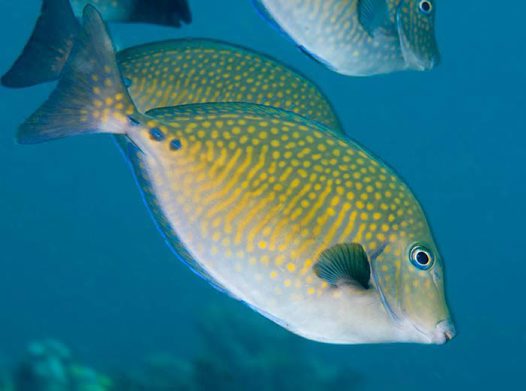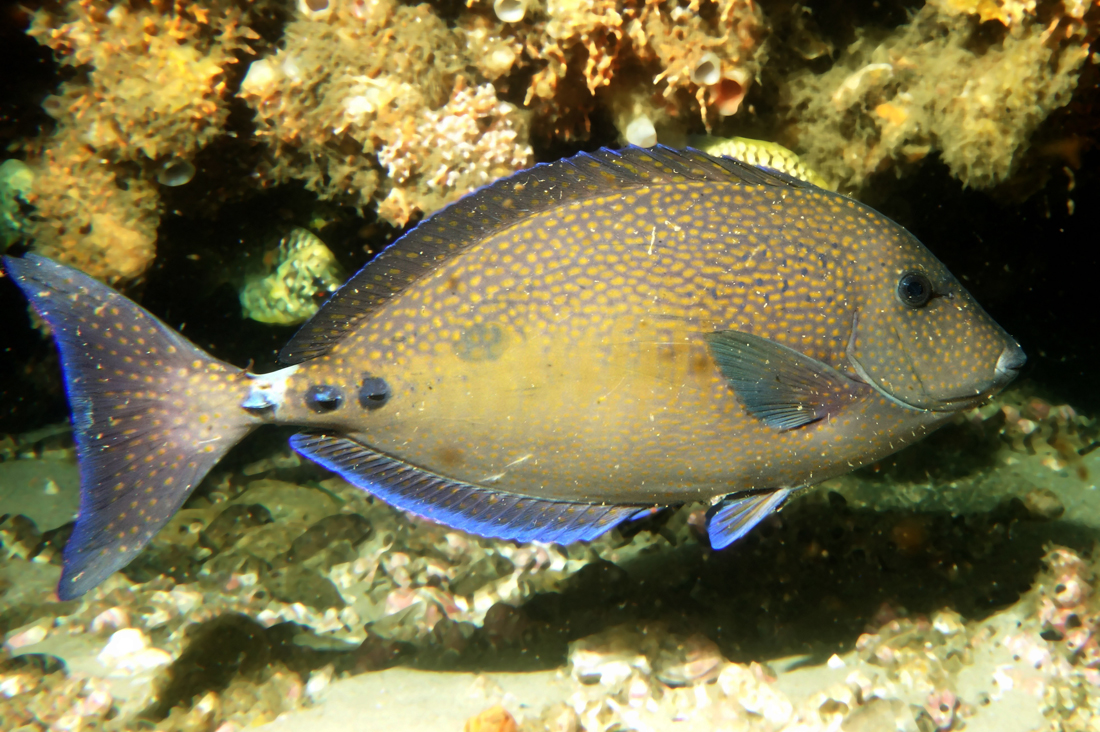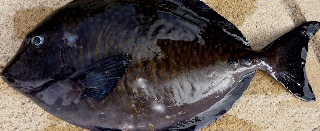
Prionurus maculatus
FAMILY
Acanthuridae
TAXONOMY
Prionurus maculatus Ogilby, 1887, Port Jackson, New South
Wales, Australia.
OTHER COMMON NAMES
German: Gelbfleken-Sдgedoktor; Japanese: Nizadai.
PHYSICAL CHARACTERISTICS
Body is compressed and slightly elongated, with a protruding
mouth and a snout with a dorsal profile that is slightly concave.
there are nine spines and 24–26 soft rays in the dorsal
fin, three spines and 23–25 soft rays in the anal fin, 17–18 soft
rays in the pectoral fin, and one spine and five rays in the
pelvic fin. the caudal fin is slightly emarginate to truncate in
shape. as with other members of this genus, this species is distinguished
by the presence of three peduncular plates, each
having a lateral keel on either side of the caudal peduncle. the
body coloration is bluish gray with several small yellow spots.
the peduncular plates are black, and the keels are blue, usually
with a white mark on the last plate. the caudal fin is gray with
yellow spots and has a deep blue margin, as does the anal fin.
juveniles have a series of narrow yellow bars that eventually,
with age, become vertical rows of yellow spots. grows to about
17.3 in (44 cm) in length.
DISTRIBUTION
Western Pacific and restricted to the Southern Hemisphere,
from southern Queensland on the Great Barrier Reef south to
New South Wales and east to Lord Howe Island, Norfolk Island,
and the Kermadec Islands. Waifs recruit seasonally to
New Zealand during warmer summer months but probably do
not reproduce successfully.
HABITAT
Tropical and warm temperate waters in protected areas of
coral reefs, rocky reefs, and bays but also on outer coral and
rocky reefs. Depth range is 6.6–98 ft (2–30 m).
BEHAVIOR
This species usually is found in aggregations.
FEEDING ECOLOGY AND DIET
Herbivorous. Feeds on benthic algae that grows mainly on
rocks or coral substrates.
REPRODUCTIVE BIOLOGY
Probably pair-spawns but also may form spawning aggregations
in which pair spawning occurs. Males probably change color
pattern to attract a female from the aggregation, and the two
touch their ventral surfaces together before the release of gametes,
without an upward dash into the water column. Eggs
and larvae are pelagic.
CONSERVATION STATUS
Not listed by the IUCN.
SIGNIFICANCE TO HUMANS
May be taken incidentally as a food fish.
Other popular Animals
Photo Gallery of - Yellowspotted sawtail





 Animalia Life
Animalia Life